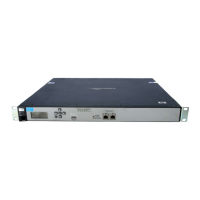Wireless configuration
Wireless coverage
4-7
Another benefit to using reduced settings is that it improves roaming performance. Wireless
users switch between APs more frequently.
Automatic transmit power control
The automatic power control feature enables the AP to dynamically adjust its transmission
power to avoid causing interference with neighboring HP ProCurve APs. For information see
Transmit power control on page 4-32.
Supporting 802.11n and legacy wireless clients
The 802.11n standard is very similar to the 802.11g standard, in that both provide mechanisms
to support older wireless standards. In the case of 802.11g, protection mechanisms were
created to allow 802.11b and 802.11g wireless devices to co-exist on the same frequencies.
The data rates of 802.11g (6, 9, 12, 18, 24, 36, 48 and 54 Mbps) are transmitted using
Orthogonal Frequency Division Multiplexing (OFDM) modulation, while the data rates of
802.11b are transmitted using Direct Sequence Spread Spectrum (DSSS) modulation. Since
older 802.11b-only clients cannot detect OFDM transmissions, 802.11g clients must “protect”
their transmissions by first sending a frame using DSSS modulation. This frame – usually a
CTS-to-self or RTS/CTS exchange – alerts 802.11b clients to not attempt to transmit for a
specified period of time.
If protection is not used, 802.11b clients may transmit a frame while an 802.11g frame is
already being sent. This leads to a collision and both devices need to re-transmit. If there are
enough devices in the network, the collision rate will grow exponentially and prevent any
useful throughput from the wireless network.
802.11n clients face the same problem as described above – legacy 802.11b clients cannot
detect the High Throughput (HT) rates that 802.11n uses. So to avoid causing excessive
collisions, 802.11n clients must use the same protection mechanisms when a legacy client is
present. Even the most efficient protection mechanism (CTS-to-self) causes a substantial
decline in throughput; performance can decline by as much as 50 percent. For this reason, the
protection behavior of the E-MSM430, E-MSM460, and E-MSM466 can be configured (see Tx
protection on page 4-30) to allow network administrators greater flexibility over their
deployments.
Note 802.11n clients can only achieve maximum throughput when legacy clients are not present on
the same radio.

